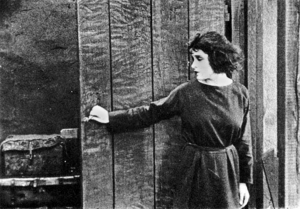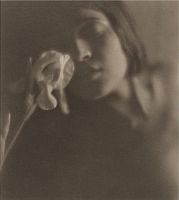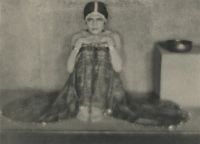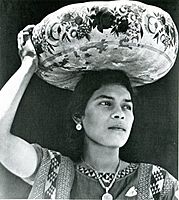Tina Modotti facts for kids
Quick facts for kids
Tina Modotti
|
|
|---|---|
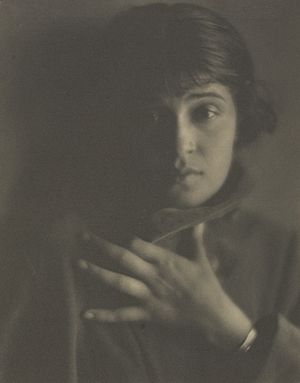
Tina Modotti photographed by Edward Weston in 1921
|
|
| Born |
Assunta Adelaide Luigia Modotti Mondini
August 16/17, 1896 |
| Died | January 5, 1942 (aged 45) |
| Nationality | Italian, American |
| Known for | Photography |
| Spouse(s) | Roubaix "Robo" de l'Abrie Richey (1918–1922, his death) Edward Weston (1921–1927) |
Tina Modotti (born Assunta Adelaide Luigia Modotti Mondini, August 16/17, 1896 – January 5, 1942) was an Italian American photographer, model, actor, and a political activist. She was born in Italy and moved to the United States in 1913. There, she lived in San Francisco with her family. Tina worked as a model and later became a photographer. In 1922, she moved to Mexico and became an active member of the Mexican Communist Party, a group that believed in a system where everyone shares resources.
Contents
Early Life and Moving to America
Tina Modotti was born in Udine, Italy. Her mother was a seamstress, and her father was a mason (a builder who works with stone or brick). Her family lived in Austria for a while as migrant workers, meaning they moved for work. They later returned to Udine, where young Tina worked in a textile factory.
In 1913, when she was 16, Tina moved to the United States to join her father in San Francisco, California. She traveled alone on a ship called the SS Moltke. She arrived at Ellis Island and then continued her journey to San Francisco.
Acting and Early Career
Tina was interested in performing arts, which were popular among the Italian community in the San Francisco Bay Area. She acted in several plays, operas, and silent movies in the late 1910s and early 1920s. She also worked as an artist's model, posing for painters and sculptors.
In 1917, she met Roubaix "Robo" de l'Abrie Richey, an artist and poet. They started a relationship in 1918, and Tina moved with him to Los Angeles to work in the movie industry. Tina's movie career included a role in the 1920 film The Tiger's Coat. She also had small parts in two other films.
Tina and Robo became friends with other artists and creative people, including the famous photographer Edward Weston.
Becoming a Photographer
Tina's uncle, Pietro Modotti, had a photography studio in Italy. Her father also briefly ran a similar studio in San Francisco. In Los Angeles, Tina met Edward Weston, who became her mentor in photography. By 1921, Tina and Edward were in a relationship.
Robo went to Mexico in December 1921, hoping to set up an art studio there. Sadly, Tina received news that he had died from smallpox in February 1922, just before she arrived to join him. Tina was very sad, but she still wanted to make Robo's dream come true. In March 1922, she helped organize an exhibition of Robo's and Edward Weston's artwork in Mexico City.
Soon after, Tina's father also passed away, and she had to return to San Francisco. In 1923, Tina returned to Mexico City with Edward Weston and his son. She agreed to manage Weston's photography studio for free, in exchange for him teaching her more about photography.
They opened a portrait studio together in Mexico City. Tina and Edward quickly became part of the city's lively art scene. They met many famous artists and thinkers, including Frida Kahlo, Diego Rivera, and Jean Charlot. Edward Weston often focused on abstract art inspired by Mexico's landscapes. Tina, however, was more interested in the people of Mexico. She wanted to "capture social realities" in her photos, showing the lives of ordinary people.
Tina also became a key photographer for the growing Mexican mural movement. She documented the large wall paintings by artists like José Clemente Orozco and Diego Rivera. Between 1924 and 1928, Tina took many photos of Rivera's murals at the Secretariat of Public Education in Mexico City. During this time, her photography style grew stronger. She took beautiful pictures of buildings, flowers, city scenes, and especially of peasants and workers.
In 1925, Tina joined International Red Aid, a group that helped people who were being treated unfairly because of their political beliefs. In November 1926, Edward Weston returned to California. Tina then met several political activists and members of the Mexican Communist Party.
Starting in 1927, Tina became much more involved in politics and joined the Mexican Communist Party. Her photography began to focus more on political themes. Her photos appeared in publications like Mexican Folkways and El Machete, which were known for their strong political messages.
A Mexican photographer named Manuel Álvarez Bravo described Tina's photography career in two parts: "Romantic" and "Revolutionary." The "Romantic" period was when she worked with Edward Weston. Her later "Revolutionary" works were shown in her own exhibition in December 1929. It was called "The First Revolutionary Photographic Exhibition In Mexico."
Life as an Activist
Tina started a relationship with Xavier Guerrero, a member of the Mexican Communist Party, in 1927. In 1928, she met and began a relationship with Julio Antonio Mella, an activist from Cuba. During this time, there was a lot of political tension in Mexico and other parts of Central and South America. People who spoke out against the government were often punished.
In 1929, Julio Antonio Mella was killed while walking with Tina. Tina was arrested right away but was later released and found innocent of his murder. Soon after, there was an attempt to kill the Mexican President. Tina was questioned about both crimes. Newspapers started a campaign against her, calling her "the fierce and bloody Tina Modotti."
Because of this campaign against her, Tina was forced to leave Mexico in 1930. She first went to Berlin, Germany, and then spent several years in Moscow, Russia. The Italian government tried to get her back to Italy because they saw her as a threat, but she managed to avoid being caught with the help of other activists.
After 1931, Tina stopped taking photographs. She dedicated her time to working for organizations that helped people in need and supported communist ideas in Europe. When the Spanish Civil War started in 1936, Tina went to Spain with Vittorio Vidali, another activist. They stayed there until 1939, helping with the war effort. She worked with Canadian Dr. Norman Bethune during a difficult retreat from Málaga in 1937. In 1939, after the war ended, Tina returned to Mexico under a different name.
Death
In 1942, Tina Modotti died at the age of 45 from heart failure. She was in a taxi on her way home in Mexico City. Some people thought her death was suspicious, but an autopsy showed she died of natural causes. Her grave is in the Panteón de Dolores cemetery in Mexico City. The famous poet Pablo Neruda wrote a special poem for her tombstone.
Murals by Diego Rivera that Include Modotti
Tina Modotti was a model for some of the famous murals by Diego Rivera.
- The Abundant Earth, The National Agricultural School, Chapingo, 1926
* Diego Rivera painted Tina five times in his murals at Chapingo, including as The Earth Enslaved and Virgin Earth.
- In the Arsenal, Secretaría de Educación Pública Building, Mexico City, 1928
* This painting shows Tina passing out ammunition, perhaps for a revolution. She is looking at her then-boyfriend, Julio Antonio Mella, while Vittorio Vidali watches over her shoulder. Tina didn't like that Rivera used details from her private life in such a public way. The main person in this painting is Frida Kahlo, who was Rivera's girlfriend at the time. Tina hosted Frida and Diego's wedding party in 1929.
Photography Exhibitions
Tina Modotti's photographs have been shown in many exhibitions around the world.
In 1996, the Philadelphia Museum of Art held a large exhibition called Tina Modotti: Photographs. The singer Madonna, who collects Tina's work, even helped raise money for the show. In 2006, the San Francisco Museum of Modern Art organized an exhibition called Mexico as Muse: Tina Modotti and Edward Weston.
Before her work was shown in the U.S., Tina's photos were displayed in Italy, Poland, Germany, Austria, and other countries. In 2010, the biggest exhibition of her work, Tina Modotti Photographer and Revolutionary, opened in Vienna, Austria. It showed 250 photographs, many of which had never been seen before.
Collections
Tina Modotti's work is kept in several important art collections:
- Art Institute of Chicago, Chicago, IL
- The Museum of Modern Art, New York
- San Francisco Museum of Modern Art, San Francisco, CA
- Metropolitan Museum of Art, New York
- Philadelphia Museum of Art, Philadelphia, PA
Gallery
Filmography
- The Tiger's Coat (Lubin Studios, 1920)
- Riding With Death (Fox Film Corporation, 1921) as "Tina Medotti"
- I Can Explain (Pathe Exchange, 1922)
- Tina Modotti (Channel 4 1992 Documentary)
See also
 In Spanish: Tina Modotti para niños
In Spanish: Tina Modotti para niños


